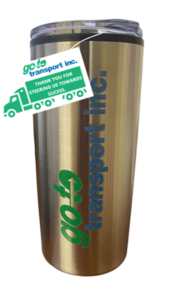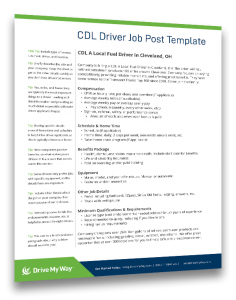
The best way to increase driver retention rates, attract qualified candidates who are the right fit for your company, and boost overall employee satisfaction is to start by asking yourself: what do drivers want?
We recently asked CDL drivers what they’re looking for from employers in 2024, and their answers might be more simple than you’d think. With responses such as better communication, dependable equipment, and increased pay, these drivers proved that it’s more important than ever to show your drivers that you are listening and willing to prioritize what they value.
If you consider actual driver needs in your recruitment efforts, while creating a company culture of support and appreciation, you are likely to increase the scope of your applicant pool and decrease driver turnover rates. Keep reading to learn what CDL drivers are looking for from employers this year, and how to utilize evolving industry trends to take this into account and stay ahead of the curve.
Competitive Pay
The trucking industry might be ever-evolving, but one concern will always remain on the top of the list for drivers. In 2024, CDL drivers will continue to view competitive pay as a major differentiating factor when applying for jobs. Drivers want to feel like their time and hardwork are valued fairly, so by providing an increase in base compensation and benefits, you will attract more qualified candidates and stand out among your competition.
In recent years, sign-on bonuses and benefit packages have continued to increase in value nationwide, a trend that will likely continue in the new year. Throughout 2023, some carriers paid as much as $200-$500 per day of driver orientation. This is a steep increase from the long standing industry standard of $100 per day.
Beyond base pay, these are some of the added benefits that drivers will care about most in 2024:
- Affordable insurance and retirement plans
- Paid time off
- Salary bonuses for safety records, taking more difficult routes, or meeting mile goals
- Sign-on and referral bonuses
- Scholarships for CDL training or for further education
Communication & Listening
An increase in base compensation recently topped the list of driver concerns in Drive My Way’s 2023 Driver Happiness Report, which collected the responses of over 500 drivers nationwide. However, nearly 10% of surveyed drivers also answered that an increase in employer communication and listening would improve their satisfaction and workplace happiness.
If you’re looking to recruit and retain quality drivers in 2024, start by showing your drivers that you value their opinions. Conducting frequent surveys and one-on-one meetings are great ways to gain employee feedback, but it’s essential to demonstrate your commitment to your drivers by actively using this feedback to adjust company policies.
Frequent touchpoints are the best way to check in with drivers to ensure that they feel listened to and that their feedback has an impact. Truck driving can be an isolating career, so it’s important to make sure each driver feels like they are part of a larger team, whether they’ve worked at the company for 6 months or 6 years.
Transparency
When looking for a job in 2024, CDL drivers value honesty and transparency more than ever. In today’s highly competitive market, drivers want to know what benefits are offered, what the application and onboarding process is like, and if there are any minimum requirements that need to be met.
Keep in mind the type of driver you are looking for when launching your driver recruiting campaign. Researching and understanding this persona will help you reach your target audience, and will also enable you to provide what that driver is seeking. For example, if your carrier allows pets or partner driving, mention that in your recruiting efforts. Even if some candidates aren’t looking for this benefit, those who are will be more inclined to apply.
Safety First
Every driver wants to feel like their employer values their safety above anything else. In a career as potentially dangerous as truck driving, drivers want to feel like their employer always has their best interests in mind.
Safety begins from day one, by conducting proper training programs during orientation and beyond. Safety regulations and protocol should be clear, accessible, and always up to date. Make sure your drivers understand the hours-of-service regulations, as well as the importance of quality rest and break time.
Today’s CDL drivers are also making clear that mental health is just as important as physical health. In fact, a 2018 study appearing in the International Journal of Environmental Research and Public Health found that the prevalence of depression in truck drivers is 13.6%, nearly double the rate found in the American public.
There are many ways to prioritize and protect your drivers’ mental health, including providing mentor programs, online resources, and company counselors. By putting your drivers’ health first, you will show your dedication to being a driver-centric company, and your commitment to the well-being of every employee.
By demonstrating your commitment to addressing CDL drivers’ top concerns, you will boost your recruitment efforts, decrease turnover rates, and foster a positive working environment.
If you’re looking for more advice on bolstering your driver recruiting and retaining efforts, be sure to check out our Employer Blog, or follow us on social media!










 If you’re dealing with high application abandonment, try putting yourself in a driver’s shoes. Most drivers don’t want to spend their limited free time filling out lengthy and complex applications. In fact, this is usually
If you’re dealing with high application abandonment, try putting yourself in a driver’s shoes. Most drivers don’t want to spend their limited free time filling out lengthy and complex applications. In fact, this is usually  Since drivers spend most of their time on the road, they mainly search for and apply to jobs using their smartphones. In this mobile-first world, recruiters and fleet managers need to make sure they’re able to communicate and interface with drivers this way. Otherwise, you risk a large number of drivers abandoning your application.
Since drivers spend most of their time on the road, they mainly search for and apply to jobs using their smartphones. In this mobile-first world, recruiters and fleet managers need to make sure they’re able to communicate and interface with drivers this way. Otherwise, you risk a large number of drivers abandoning your application. While you, as a recruiter can create what you think is the most efficient, painless, and all-around great application experience, you won’t really know how it is until drivers start applying. Even when they do start, it can be hard to gauge what’s working and what’s not since gathering data around job application abandonment can prove to be difficult.
While you, as a recruiter can create what you think is the most efficient, painless, and all-around great application experience, you won’t really know how it is until drivers start applying. Even when they do start, it can be hard to gauge what’s working and what’s not since gathering data around job application abandonment can prove to be difficult.


 When speaking with driver candidates, be sure you’re an expert on your company and the particulars of the job. Know what the day-to-day will look like and give honest answers. Don’t sugarcoat things if you know that your company might not have the world’s best benefits or if the pay might not be at the top of the scale.
When speaking with driver candidates, be sure you’re an expert on your company and the particulars of the job. Know what the day-to-day will look like and give honest answers. Don’t sugarcoat things if you know that your company might not have the world’s best benefits or if the pay might not be at the top of the scale.  This may sound obvious, but you’d be surprised how many recruiting departments lack a cohesive plan for how to bring drivers into their organization. While each hiring plan will vary from carrier to carrier, all of them should have two things in common. They should be measurable and repeatable.
This may sound obvious, but you’d be surprised how many recruiting departments lack a cohesive plan for how to bring drivers into their organization. While each hiring plan will vary from carrier to carrier, all of them should have two things in common. They should be measurable and repeatable. Comprehensive CDL Recruitment Solutions
Comprehensive CDL Recruitment Solutions

